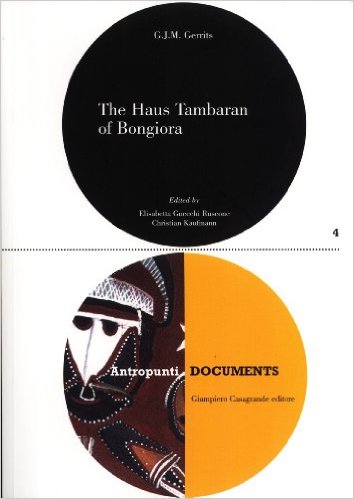Museo delle Culture uses cookies to improve the user experience. If you need more information click on the privacy page. Privacy policy X
05 July 2012 - 09 September 2012, Heleneum - Lugano
The temporary exhibition “Haus tambaran” draws its name from the large ceremonial houses, which functioned as cathedrals, parliaments and theatres, and were not only the topographic but also the ideological, artistic and religious centre of most villages in Papua New Guinea.
37 unpublished photographs of Dadi Wirz will be displayed at the Heleneumfrom the 6th of July to the 9th of September 2012. These photographs are part of a collection of over 800 negatives, which were taken during his travels in Papua New Guinea between 1952 and 1955. They are now stored in the museum’s Documentation and Research Centre.This integrated project presents the public with a fascinating reportage and the synthesised results of a larger project.
The temporary exhibition is in fact accompanied by the publication of Fred Gerrits’ book, entitled The Haus Tambaran of Bongiora. This book will be the fourth issue of the “Antropunti” series and explains the results of a long-term research project which Gerrits started in 1972, and conducted with the help of his wife and a group of leaders of the Abelam villages Bongiora and Kuminibis in Papua New Guinea. They devoted their research to the ideological system which intimately connects ceremonies and traditional art, and documents the historical last moments before a man’s death.
In the next few years the Museo delle Culture will continue its research on the work of Dadi and his father Paul Wirz (1892-1955), who was perhaps the most important Swiss anthropologist of the 20th Century. Paul Wirz explored the reasons behind the creativity of a number of Oceanic and Indonesian peoples, by using modern anthropological tools. The Museo delle Culture will collaborate with several other prestigious European and American partners, who all share the Wirz’s cultural and material heritage.
Fred Gerrits was born in 1933 in Bandung, in Indonesia. After graduating with a degree in medicine in Holland, he settled in Papua New Guinea in the 1950s, where he met his future wife Nel. As of 1964 the Gerrits worked in various hospitals, until Fred was appointed as the Tuberculosis and Leprosy Control Officer for the provinces of West and East Sepik, with a base in Maprik at the foot of the Prince Alexander Mountains. In beginning of the 1970s, the Gerrits’ interest in anthropology and photography encouraged them to conduct a systematic collection of evidence. Thanks to their long stay in the area, they were able to study regions of intense artistic and thematic vitality hitherto little known. After having moved first to Kenya and then to Nepal, the couple now lives in Australia, where Fred worked until his retirement as a consultant for international health organizations operating in Southeast Asia and the Pacific.
Dadi Wirz was born in 1931 in Papua New Guinea. He spent his childhood and youth on a constant pilgrimage in the South Seas with his father Paul Wirz (1892 – 1955) who travelled thoughout the world for his research. After studying photography in Basel and Paris, Dadi Wirz moved to Brazil in search of creative stimuli. After the death of his father, he returned several times to Papua New Guinea to conduct ethnological research and especially to capture with his camera a world that he felt was seeing its last days. Since the 1970s Wirz has lived first in Morocco, then Portugal and England, devoting himself to his versatile artistic passions: engraving, painting, sculpting and photograpy. In addition, he has taught at the Schule für Gestaltung in Basle, the Ecole du Louvre in Paris, the Rhode Island School of Design in Providence (USA), the Museu de Arte Moderna in Rio de Janeiro and at many other universities.
“Antropunti” is the multi-purpose medium of the museum’s projects and its scientific, educational and promotional activities. It is a sort of modern medley of all anthropological and artistic ideas, reflections and research. The series presents texts and images in printed, audiovisual and multimedia formats, and is divided into five thematic sections that document the various areas of the museum’s Activity System: the “Atti” (Proceedings) display the outcomes of seminars and higher education activities; the “Documenti” (Documents) present the current research projects and their results; the “Guide” (Guides) offer guided tours and insights into the museum’s collections; the “Parole e suoni” (Words and Sounds) section hosts volumes of fairy tales, myths, stories, songs and other forms of narrative and poetic expression of the traditional cultures; the “Strumenti” (Tools) are educational and informative publications that specify the museum’s technical and operational activities.
